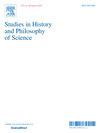历史科学中的测量、分解和水平转换:地质年代和科学方法的本体论。
IF 1.8
2区 哲学
Q1 HISTORY & PHILOSOPHY OF SCIENCE
引用次数: 0
摘要
历史科学的哲学家们在很大程度上关注这些科学面临的知识获取问题:与现在相比,历史科学家如何克服过去数据的相对稀缺?解决这个问题通常需要解决另一个问题,我称之为“实体访问问题”:历史科学家如何访问具有潜在信息过去属性的实体和过程?地质年代学的例子说明了这个问题的一个解决方案:历史科学家可以通过利用其领域的形而上学结构,获得具有潜在的关于过去信息的属性的实体和过程。地质年代学在20世纪经历了其研究边界的惊人爆发。我通过分析地质年代学技术中隐含的本体论来解释这种生产力。同位素地质年代学的生产力是基于(a)气象学分解,以便(b)利用部分和整体之间获得的性质差异,以及(c)质谱法与较低级性质之间的特殊互补性,允许应用于广泛的地质背景。科学家利用其领域的形而上学结构的技术中介能力对他们的成功至关重要。本文章由计算机程序翻译,如有差异,请以英文原文为准。
Measurement, decomposition and level-switching in historical science: Geochronology and the ontology of scientific methods
Philosophers of the historical sciences have focused to a significant extent on the problem of epistemic access facing these sciences: how do historical scientists overcome the relative scarcity of data about the past, compared to the present? Solving this problem usually requires solving another one, which I call the ‘problem of ontic access:’ how do historical scientists get access to entities and processes with properties that are potentially informative about the past? The case of geochronology illustrates one solution to this problem: historical scientists can get access to entities and processes with properties that are potentially informative about the past by exploiting the metaphysical structure of their domain. Geochronology experienced a spectacular explosion of its research boundaries in the 20th century. I explain this productivity by analyzing the ontology implicit in geochronological techniques. The productivity of isotope geochronology was based on (a) mereological decomposition in order to (b) exploit differences of properties obtaining between the parts and the whole, and (c) an exceptional complementarity between mass spectrometry and the lower-level properties, allowing application to a wide range of geological contexts. The technologically mediated ability of the scientists to exploit the metaphysical structure of their domain was crucial to their success.
求助全文
通过发布文献求助,成功后即可免费获取论文全文。
去求助
来源期刊

Studies in History and Philosophy of Science
管理科学-科学史与科学哲学
CiteScore
2.50
自引率
10.00%
发文量
166
审稿时长
6.6 weeks
期刊介绍:
Studies in History and Philosophy of Science is devoted to the integrated study of the history, philosophy and sociology of the sciences. The editors encourage contributions both in the long-established areas of the history of the sciences and the philosophy of the sciences and in the topical areas of historiography of the sciences, the sciences in relation to gender, culture and society and the sciences in relation to arts. The Journal is international in scope and content and publishes papers from a wide range of countries and cultural traditions.
 求助内容:
求助内容: 应助结果提醒方式:
应助结果提醒方式:


